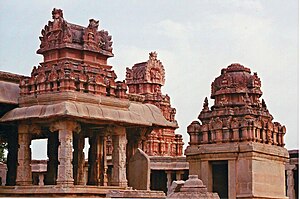Balakrishna
In Krishna religiosity , the child Balakrishna ( Sanskrit बालकृष्ण bālakṛṣṇa ), among other aspects of Krishna , was introduced to the child in the 4th century BC. Chr. Veneration brought.
etymology

Balakrishna, literally child Krishna , is sometimes translated as God's child Krishna .
Worship Krishna
The present homage to Krishna is an amalgam of different elements. The original worship of Krishna-Vasudeva flourished in Mathura several centuries before the birth of Christ (references in Megasthenes and in the Arthashastra of Kautilya suggest that Krishna as Vasudeva's son as early as the 4th century BC as perfect, eternal and gracious Supreme Deity was worshiped in a strictly monotheistic framework). It was followed by the Krishna Govinda cult and a little later the worship of Balakrishna, which plays an important role in present-day Krishnaism. The last element of worship is Krishna-Gopijanavallabha , that is, Krishna as the lover of the Gopis , among whom Radha occupies a privileged position. The development culminated in the worship of Radha-Krishna as Svayam Bhagavan . Today's monotheistic Krishna religion is based on the elements already mentioned, on monotheistic Bhagavatism . Balakrishna receives less attention, although he is one of the most popular deities in many parts of India today .
iconography
Balakrishna is often depicted as a toddler crawling on his hands and knees, occasionally dancing with a piece of butter in his hand.
Several miraculous acts are attributed to Bala Krishna. He is said to have killed the giant monster Putana (पूतना) by simultaneously sucking the life force out of her poisoned breasts with the poison.
Balakrishna is also often depicted as he is carried over the Yamuna by his father Vasudeva on the way from Mathura to Vrindavan or as he is bathed by his mother Yashoda . The childhood episodes of Krishna became the focus of medieval cult worship, which manifested itself in numerous movements in India.
In the Bhagavad Gita Krishna then teaches a universal, monotheistic religion of a God personified and reveals himself as the almighty God svayam bhagavan .
Temple and figure
In 1513 the ruler Krishnadevaraya had the temple of the same name built for Balakrishna in Hampi ( Vijayanagara in Karnataka , South India). The main altar of the Balakrishna Temple is dedicated to Balakrishna. Balakrishna Temple is one of the few examples where stories from the Puranas have been carved into the walls of the temple and the main tower.
A famous murti (figurehead) of Balakrishna is in Udupi . It was set up by Madhvacharya (1238 to 1317/1319) in his Sri Krishna Matha and can still be viewed by pilgrims in his monastery today. The same figure is said to have been worshiped by Rukmini , Krishna's wife, and then delivered across the sea from Dwarka .
There is a legend that Madhvacharya is said to have saved floating ships. As a thank you, he received two huge Chandan clay balls . To the astonishment of those involved, two statues were hidden in the spheres, one of Krishna and one of Balarama . The Krishna statue held a whorl in its hand and was baptized Balakrishna. It was then placed in the main shrine of Udupi. Madhvacharya then lit sacred ritual lamps at the feet of the statue, which to this day have been burning continuously for 700 years since the 14th century .
Hinduism in the Western World
At the very beginning of his endeavor to establish Hindu Krishna temples in the western world, AC Bhaktivedanta Swami Prabhupada wanted to establish a temple in New York , which would be dedicated to Balakrishna. Even before he started ISKCON , he wrote to one of his patrons in India:
“I therefore believe that a Balakrishna temple in New York should be established immediately for this purpose. As a devotee of Balakrishna, you should do this great and honorable work. To this day there is no decent Hindu temple in all of New York, whereas there are many American missionary stations and churches in India. "
At the present time, Balakrishna is a popular deity in the Western world among Hindus of various traditions, including the International Society for Krishna Consciousness .
See also
literature
- Norvin Hein: A Revolution in Kṛṣṇaism: The Cult of Gopāla . In: History of Religions . tape 25 , no. 4 , 1986, pp. 296-317 , JSTOR : 1062622 .
- Milton Singer: Krishna Myths Rites & Attitudes . University of Chicago, 1900, ISBN 0-313-22822-1 .
- N. Delmonico: The Hare Krishna Movement: the Postcharismatic Fate of a Religious Transplant . Columbia University Press, 2004, ISBN 0-231-12256-X .
Web links
Individual evidence
- ^ Klostermaier, Klaus K .: A Survey of Hinduism . 3. Edition. State University of New York Press, 2005, ISBN 0-7914-7081-4 , pp. 206 .
- ↑ James Rodney Hastings: Encyclopedia of Religion and Ethics . 13 volumes. Kessinger Publishing, LLC, Edinburgh, OCLC 849058642 (2nd edition 1925–1940, reprints 1955, 2003).
- ^ Satsvarupa dasa Goswami: The Qualities of Sri Krsna . GNPress, 1998, ISBN 0-911233-64-4 , pp. 152 .
- ^ A b Barbara Stoler Miller, John C. Hawley: Love Song of the Dark Lord . Columbia University Press, New York 1997, ISBN 0-231-11097-9 .
- ↑ Kim Knott: Hinduism: a very short introduction . Oxford University Press, Oxford [Oxfordshire] 1998, ISBN 0-19-285387-2 , pp. 33 .
- ↑ CM Padmanabhacharya: Life and Teachings of Sri Madhvachariya . 1983.
- ↑ Satsvarupa dasa Goswami: Srila Prabhupada Lilamrta . tape 1-2 (1980-82) . GN Press, OCLC 233672227 .


